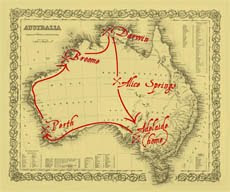Listen up class, repeat after me. "Tourists, where ever they may be, do not rise before nine, and do not leave their accommodation until after 10. Therefore, tourist crowds will only be seen sometime after 11."
Rottnest Island, 30km west of Fremantle port

I thought I had the island to myself, until after eleven when other tourists arrived on the beaches by bike or by bus. I, of course, as are my ways, had started cycling the 30 kilometre circuit around the island at eight am. In that time time I saw almost no-one, beach after beach was all mine.

Little Salmon Bay was the pick of the beaches, small, white sand, light blue water, contained by limestone headlands. Complete with a snorkeling trail. Perfect. As I pulled up on my bike, a guy rode in from the opposite direction, my first sighting of anyone else today. He had his snorkeling gear out in no time and was prepping up in the water. It was all the encouragement I needed, I'm not always the keenest to set out snorkeling. Thankful for my wetsuit, I headed out, the other guy still messing about in the shallows. Following the underwater snorkeling trail, I saw many different fish, including salmon of course. Lots of colours and stripes, this area of Western Australia attracts tropical fish due to the southerly currents. Glancing back at the shore, the guy was still messing around on the shore, next time I glanced back he was back on his bike, the water must have been too cold for him. Having talked to him on the beach he seemed pretty keen, perhaps in him encouraging me into the water I discouraged him out of it.
Sitting back on the beach in the warm sun, the bikes and busloads soon turned up. Alas, it had been all mine for awhile there. Later in the day I found myself another deserted beach to call my own, up near the World War II ruins.
Rottnest Island is a curious one. For one thing, it must have little less than 1,000 holiday units, most seemingly identical built over a couple of generations. Almost all empty, indeed, the island is pretty deserted overall. It's not tourist season here anymore, in the unpredictable winter weather. For me though it was nothing but three days of beautiful clear sunny skies.

In amongst the holiday units are some much older buildings, some from the time of either of the prisons built here, others from later tourist development or war use. Many fascinating historical buildings. The general store and mall form part of the original prison. Much of the complex has been destroyed by fire or demolished so it is hardly recognisable as one. The second prison remains, although is a hotel now so cant be toured.
The original cottages are fascinating. Built of local limestone, they were rendered in the early 1900s and painted a cream colour to reduce the sun glare. The colour and building material theme has been maintained throughout the two major accommodation areas. The cottages originally had near-flat roofs, limestone supported by timber trusses. The timber trusses were each made from a single piece of timber, ingenious. Tiles were too expensive to bring in from Fremantle, but in time corrugated iron replaced the roofs as they were difficult to keep watertight.
The museum was interesting, detailing the many shipwrecks and the dark history of the island. The two prisons were built by and detained Aboriginal people, many of whom were sent here for the European laws that had been imposed upon them. Many prisoners came from the far north of the state, the cold weather must have been quite a shock. The conditions were cramped and the inmates mistreated. One prison governor though allowed them to leave the prison each Sunday between nine am and four pm. They were provided with no lunch or dinner, but instead could roam the island and catch their dinner, quokkas, snakes or whatever.

After my cycling tour of the island it occurred to me that this island was missing a cemetery. I found a reference to one on the map, but could find little sign of it in reality. The cemetery was only used for the Aboriginal prisoners, and none of the graves is marked. Buildings and houses have been built over some of it, worse still, some of the cemetery has been used as the main camping ground. I had wondered why the camping ground, often called a Tent City, could only consist of 20 marked sites. No tent city that one. But it isn't the original camping ground, but a new one constructed in the last few years. I found the original sprawling camping ground, much of it on the cemetery. The only sign it is a burial ground is two signs near the township end, noting the site's importance and the future plans for removing all buildings and creating a memorial garden and marking the known burial areas.

Around the turn of the century the island started being used for tourism, with a few interludes during war time. During the Second World War several artillery guns were installed, and monitoring towers. 2,500 soldiers were housed here, protecting Fremantle Harbour from invasion by the Japanese.
I cant finish this entry about Rottnest Island though without mentioning the quokkas. I saw my first ones within a two of minutes of landing, and by the end of the third minute I had seen some copulating. Cute as they are they don't seem to sleep, constantly poking around my tent despite my food all being well sealed and isolated.
|
Download kml file of Rottnest Island circuit to view in Google Earth or adapt to use as a navigational aid in a GPS unit |
Stats
|
Rottnest Island circuit |
Thursday |
3/6/2010 |
Distance |
31km |
Moving Duration |
2h30m |






































